A Positioning Error Compensation Method for a Mobile Measurement System Based on Plane Control
Abstract
1. Introduction
2. Analysis of Position and Orientation Error Characteristics
3. Positioning Error Compensation Based on Plane Control
3.1. Laser Point Cloud Localization Equation
3.2. Positioning Error Solving Principle
3.3. Similar to the Gaussian Distribution Function Error Compensation Model
4. Experimental Analysis
4.1. Experimental Platform and Control Plane Selection
4.2. Positioning Error Simulation Analysis
4.3. Positioning Error Compensation Experiment
5. Conclusions
Author Contributions
Funding
Acknowledgments
Conflicts of Interest
References
- Wan, R.; Huang, Y.; Xie, R.; Ma, P. Combined Lane Mapping Using a Mobile Mapping System. Remote Sens. 2019, 11, 305. [Google Scholar] [CrossRef]
- Cui, T.; Ji, S.; Shan, J.; Gong, J.; Liu, K. Line-Based Registration of Panoramic Images and LiDAR Point Clouds for Mobile Mapping. Sensors 2017, 17, 70. [Google Scholar] [CrossRef] [PubMed]
- Nivedita, S.; Sudhagar, N.; Scott, O. Development of mobile mapping system for 3D road asset inventory. Sensors 2016, 16, 367. [Google Scholar]
- Borja, R.C.; Silverio, G.C.; Celestino, O.; Maria, C.A. An approach to detect and delineate street curbs from MLS 3D point cloud data. Autom. Constr. 2015, 51, 103–112. [Google Scholar]
- Fryskowska, A.; Wroblewski, P. Mobile laser scanning accuracy assessment for the purpose of base-map updating. Geod. Cartogr. 2018, 67, 35–55. [Google Scholar]
- Handel, P.; Ohlsson, J.; Ohlsson, M. Smartphone-Based Measurement Systems for Road Vehicle Traffic Monitoring and Usage-Based Insurance. IEEE Syst. J. 2014, 8, 1238–1248. [Google Scholar] [CrossRef]
- Yu, M.J. INS/GPS integration system using adaptive filter for estimating measurement noise variance. IEEE Trans. Aerosp. Electron. Syst. 2012, 48, 1786–1792. [Google Scholar] [CrossRef]
- Puente, I.; González-Jorge, H.; Martínez-Sánchez, J.; Arias, P. Review of mobile mapping and surveying technologies. Measurement 2013, 46, 2127–2145. [Google Scholar] [CrossRef]
- Barber, D.; Mills, J.; Smith-Voysey, S. Geometric validation of a ground-based mobile laser scanning system. ISPRS J. Photogramm. Remote Sens. 2008, 63, 128–141. [Google Scholar] [CrossRef]
- Peng, K.Y.; Lin, C.A.; Chiang, K.W. The performance analysis of an AKF based tightly-coupled INS/GPS integrated positioning and orientation scheme with odometer and non-holonomic constraints. Int. Arch. Photogramm. Remote Sens. Spat. Inf. Sci. 2012, XXXIX-B7, 481–486. [Google Scholar] [CrossRef]
- Angrisano, A.; Gaglione, S.; Gioia, C. Performance assessment of GPS/GLONASS single point positioning in an urban environment. Acta Geod. Geophys. Hung. 2013, 48, 1–13. [Google Scholar] [CrossRef]
- Klein, I.; Filin, S.; Toledo, T. Vehicle constraints enhancement for supporting INS navigation in urban environments. Navigation 2011, 58, 7–15. [Google Scholar] [CrossRef]
- Vagle, N.; Broumandan, A.; Lachapelle, G. Multi-Antenna GNSS and Inertial Sensors/Odometer Coupling for Robust Vehicular Navigation. IEEE Internet Things J. 2018, 5, 4816–4828. [Google Scholar] [CrossRef]
- Broumandan, A.; Lachapelle, G. Spoofing detection using GNSS/INS/Odometer coupling for vehicular navigation. Sensors 2018, 18, 1305. [Google Scholar] [CrossRef]
- Gong, X.; Zhang, R.; Fang, J. Application of unscented R–T–S smoothing on INS/GPS integration system post processing for airborne earth observation. Measurement 2013, 46, 1074–1083. [Google Scholar] [CrossRef]
- Shi, B.; Lu, X.; Chen, Y.F. Improving position and attitude precision of GPS/INS by applying EKF smoothing algorithm. J. Geomat. Sci. Technol. 2012, 29, 334–338. [Google Scholar]
- Qiu, R.; Cheng, Y. The interpolation application of interval quartering algorithm of singular spectrum analysis iterative in GPS coordinate time series. J. Geod. Geodyn. 2015, 35, 1031–1035. [Google Scholar]
- Liu, S.; Sun, F.; Li, H. Forward-backward-smoothing algorithm with application to tightly coupled PPP/INS data post-processing. J. Chin. Inert. Technol. 2015, 23, 85–91. [Google Scholar]
- Liu, H.; Nassar, S.; El-Sheimy, N. I Two-Filter Smoothing for Accurate INS/GPS Land-Vehicle Navigation in Urban Centers. IEEE Trans. Veh. Technol. 2010, 59, 4256–4267. [Google Scholar] [CrossRef]
- Nassar, S.; Niu, X.; El-Sheimy, N. Land-Vehicle INS/GPS accurate positioning during GPS signal blockage periods. J. Surv. Eng. 2007, 133, 134–143. [Google Scholar] [CrossRef]
- Takai, S.; Date, H.; Kanai, S.; Niina, Y.; Oda, K.; Ikeda, T. Accurate registration of MMS point clouds of urban areas using trajectory. ISPRS Ann. Photogramm. Remote Sens. Spat. Inf. Sci. 2013, II-5/W2, 277–282. [Google Scholar] [CrossRef]
- Schaer, P.; Vallet, J. Trajectory adjustment of mobile laser scan data in GPS denied environments. ISPRS Ann. Photogramm. Remote Sens. Spat. Inf. Sci. 2016, XL-3/W4, 61–64. [Google Scholar] [CrossRef]
- Han, J.Y.; Chen, C.S.; Lo, C.T. Time-Variant registration of point clouds acquired by a mobile mapping system. IEEE Geosci. Remote Sens. Lett. 2013, 11, 196–199. [Google Scholar] [CrossRef]
- Kai-Wei, C.; Trung, D.T.; Liao, J.K. On-Line smoothing for an integrated navigation system with Low-Cost MEMS inertial sensors. Sensors 2012, 12, 17372–17389. [Google Scholar]
- Sharkarji, C.M. Least-Squares fitting algorithms of the NIST algorithm testing system. J. Res. Natl. Inst. Stand. Technol. 1998, 103, 633–641. [Google Scholar] [CrossRef] [PubMed]
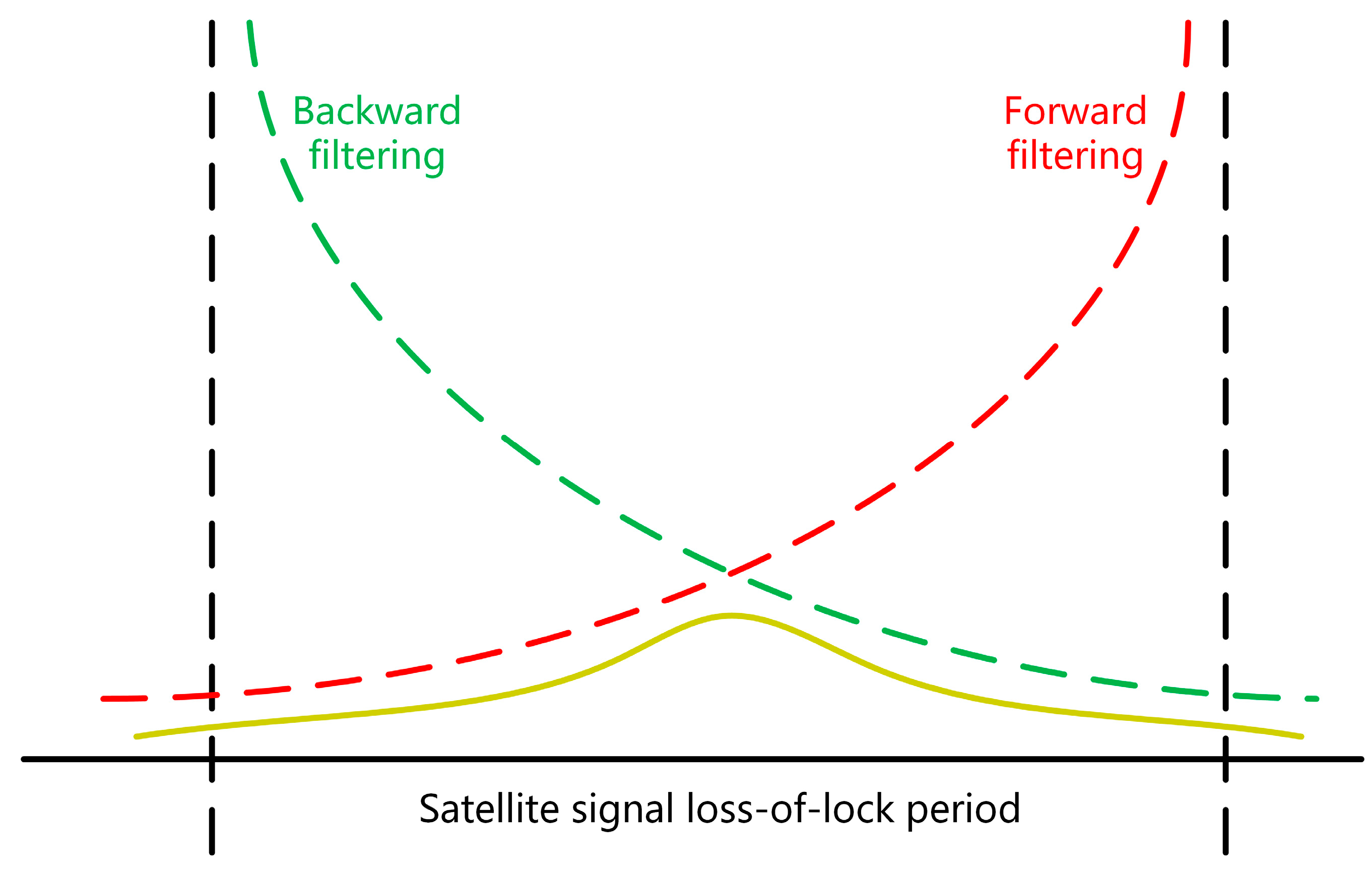
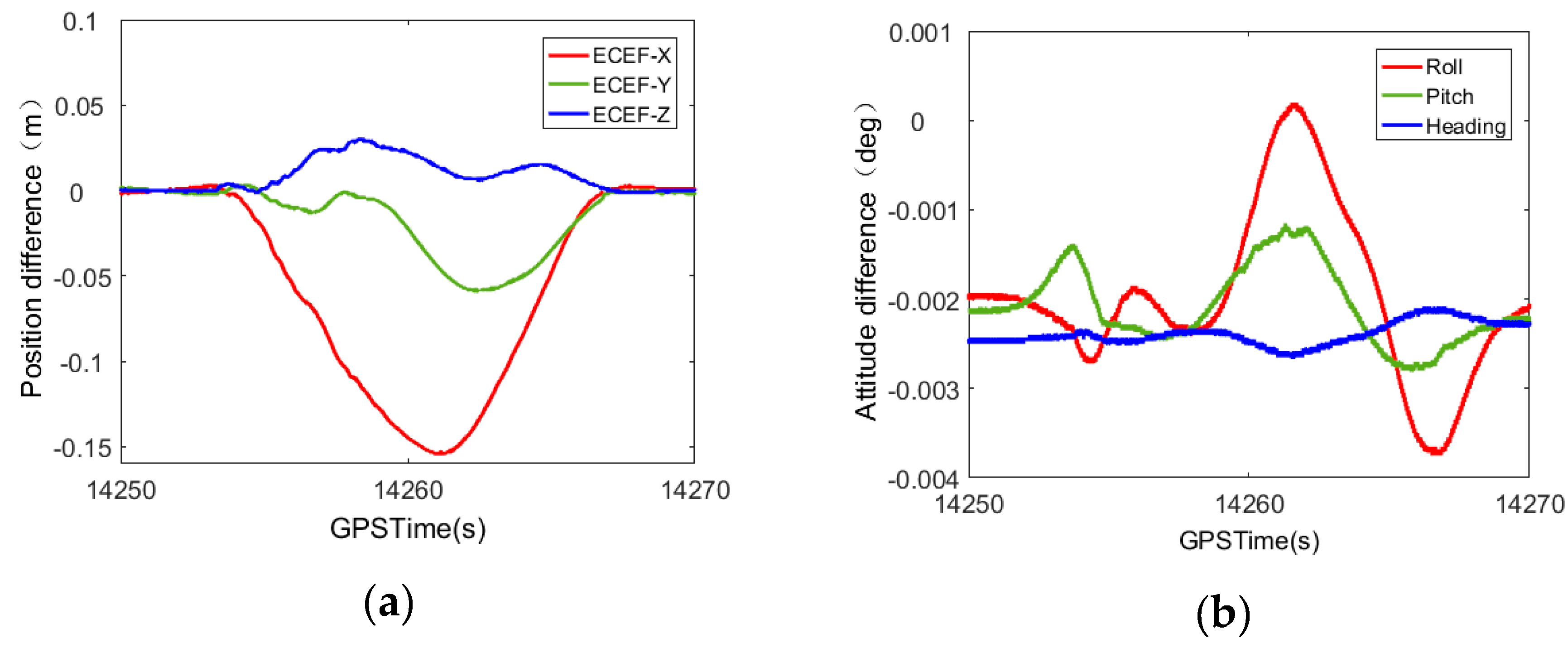


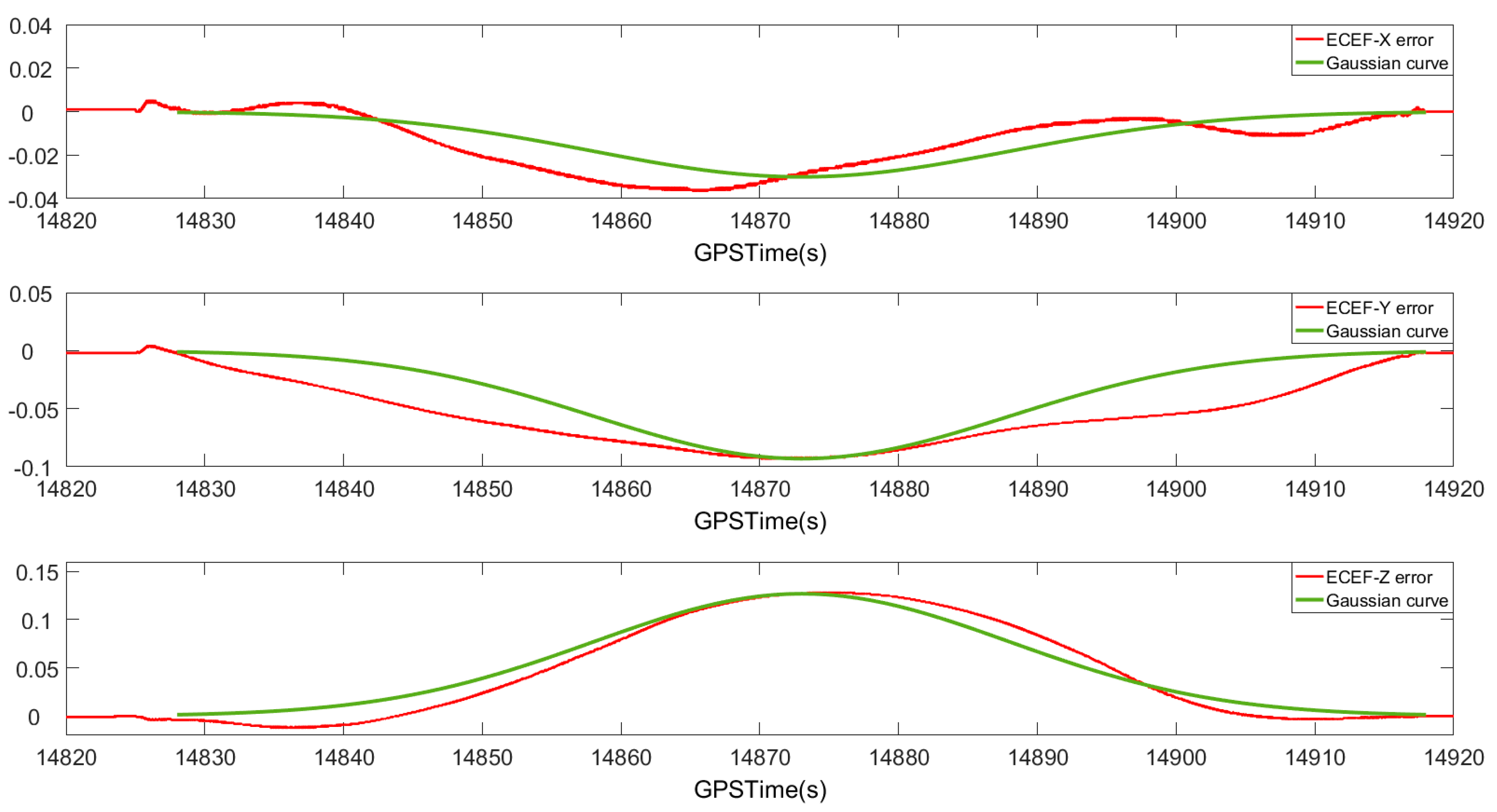
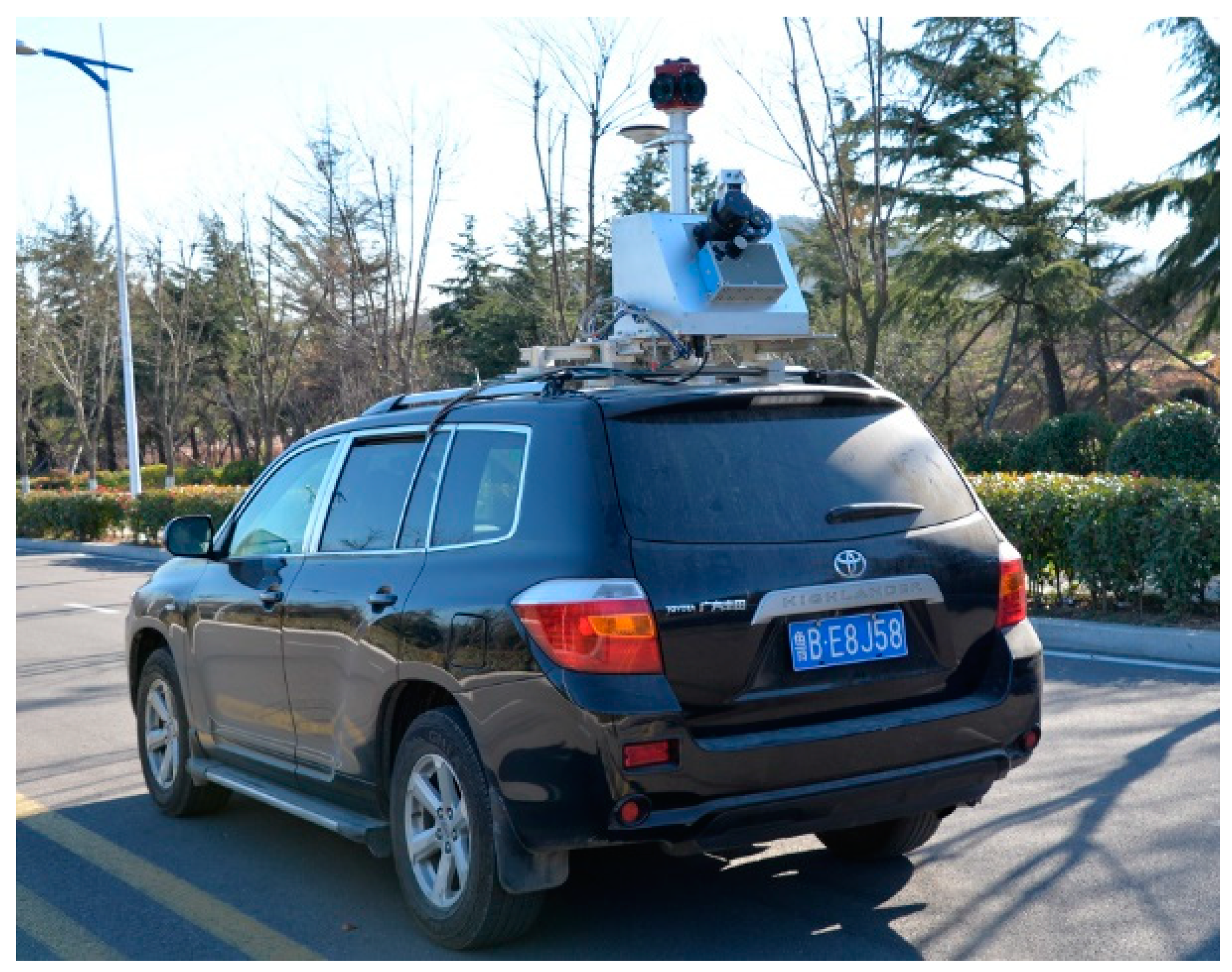

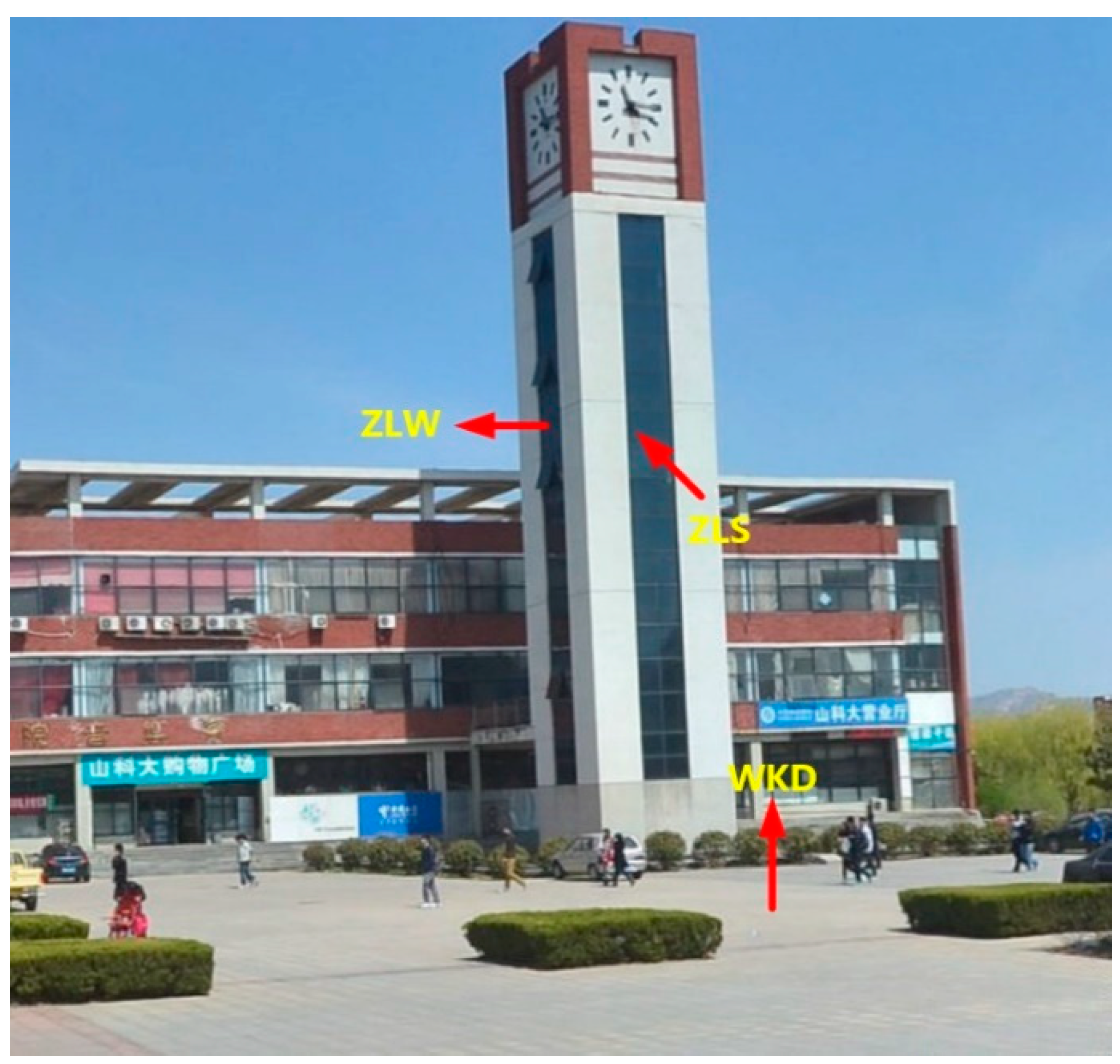

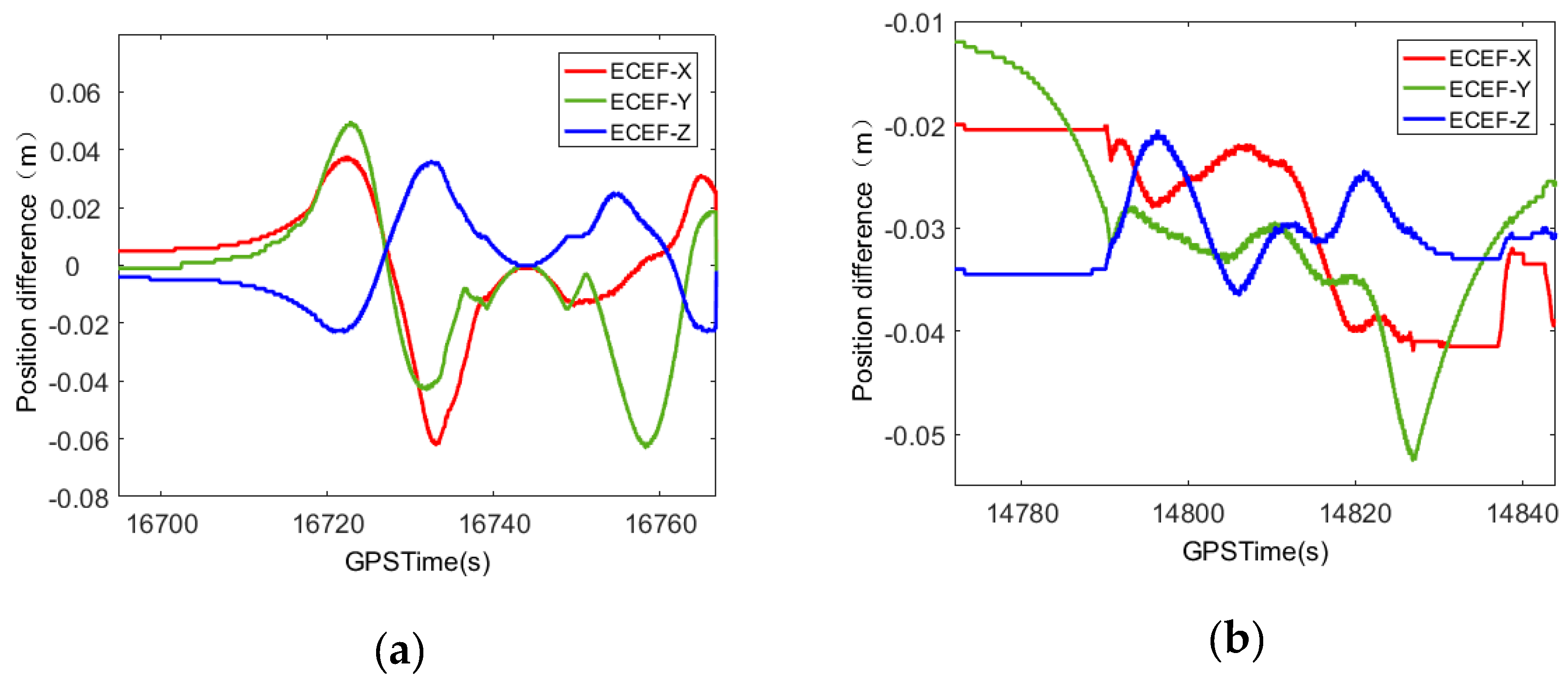

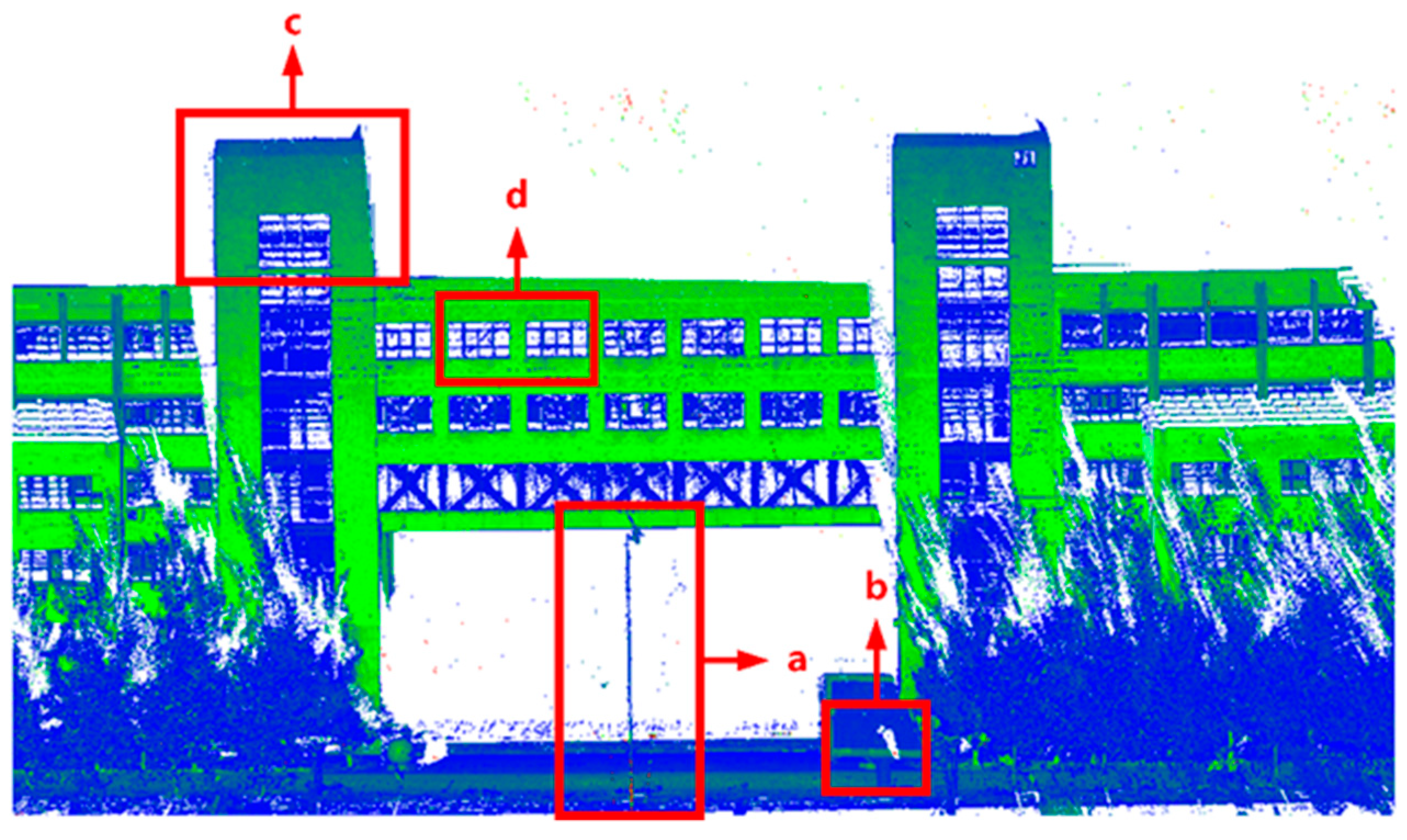
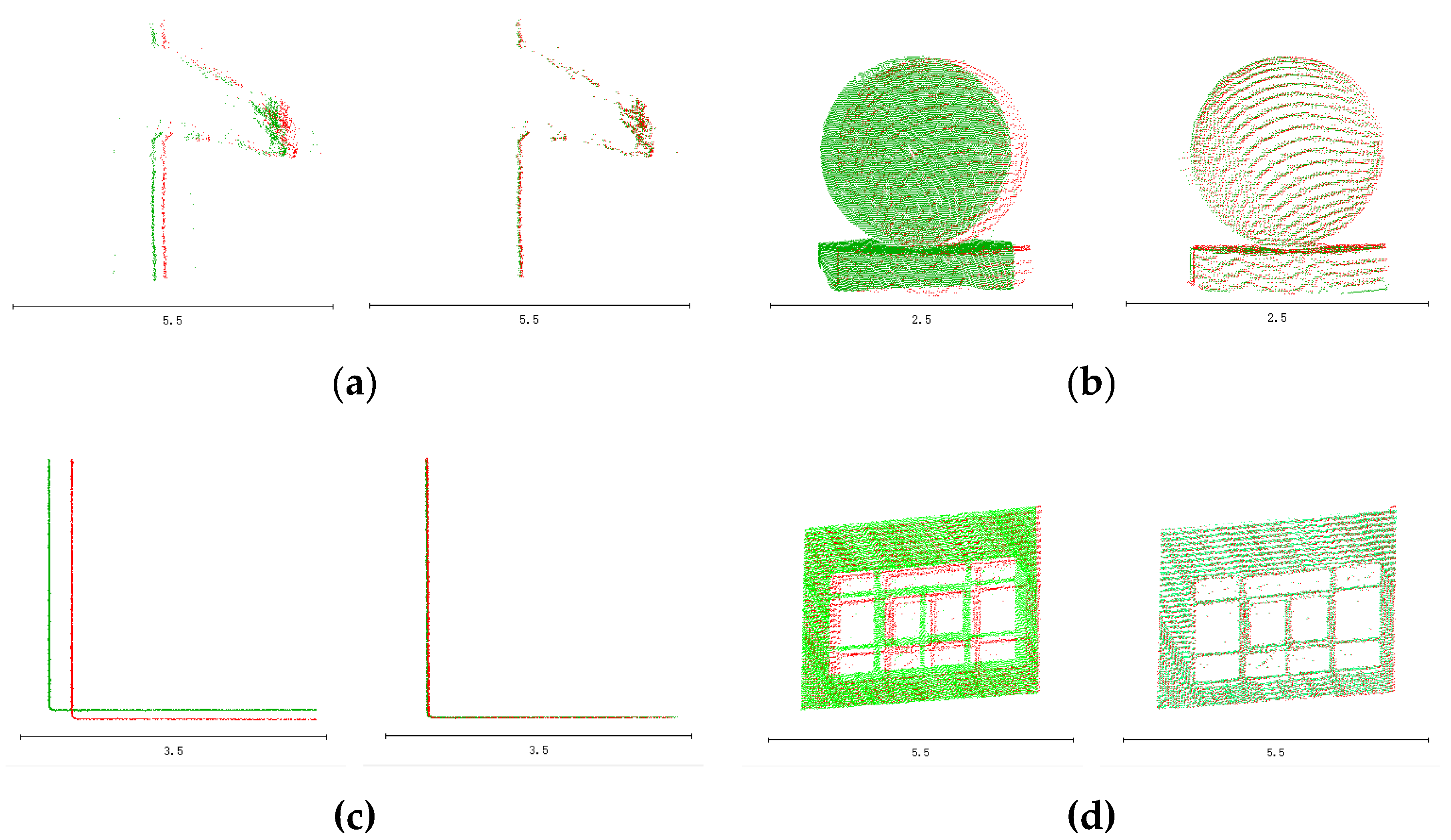
| Time | ECEF-X (m) | ECEF-Y (m) | ECEF-Z (m) | Roll (deg) | Pitch (deg) | Yaw (deg) |
|---|---|---|---|---|---|---|
| 1-min | 0.158 | 0.059 | 0.033 | 0.0045 | 0.0016 | 0.0011 |
| 3-min | 0.400 | 1.005 | 0.210 | 0.0042 | 0.0062 | 0.0065 |
| Sensor | Technical Parameters | |
|---|---|---|
| Laser scanner (Z+F PROFILER 9012) | Laser class | 1 |
| Ambiguity distance (m) | ≤0.001 | |
| Angular resolution (deg) | 0.0088° | |
| POS(SPAN-LCI) | Position Accuracy/Vertical Position Accuracy (m) | 0.01/0.015 |
| Pitch/Roll Angle Accuracy (deg) | 0.005 | |
| Heading Angle Accuracy (deg) | 0.008 | |
| Simulation Constant Error | This Paper Obtained the Positioning Error | |||||||
|---|---|---|---|---|---|---|---|---|
| ECEF-X (m) | ECEF-Y (m) | ECEF-Z (m) | Roll (deg) | Pitch (deg) | Yaw (deg) | ECEF-X (m) | ECEF-Y (m) | ECEF-Z (m) |
| 0.05 | 0.05 | 0.05 | 0.005 | 0.005 | 0.005 | 0.0492 | 0.0488 | 0.0498 |
| 0.10 | 0.10 | 0.10 | 0.005 | 0.005 | 0.005 | 0.0992 | 0.0988 | 0.0998 |
| 0.15 | 0.15 | 0.15 | 0.005 | 0.005 | 0.005 | 0.1492 | 0.1488 | 0.1498 |
| 0.05 | 0.05 | 0.05 | 0.008 | 0.008 | 0.008 | 0.0487 | 0.0481 | 0.0504 |
| 0.05 | 0.05 | 0.05 | 0.010 | 0.010 | 0.010 | 0.0484 | 0.0476 | 0.0495 |
| 0.05 | 0.05 | 0.05 | −0.005 | −0.005 | −0.005 | 0.0508 | 0.0512 | 0.0502 |
| −0.05 | −0.05 | −0.05 | −0.005 | −0.005 | −0.005 | −0.0492 | −0.0488 | −0.0498 |
| Plane | Before Compensation (m) | After Compensation (m) |
|---|---|---|
| EJ1E | 0.083 | 0.010 |
| J1D | 0.030 | 0.009 |
| J1DN | 0.026 | 0.009 |
| J1L | 0.123 | 0.010 |
| J1M | 0.078 | 0.008 |
| J1R | 0.044 | 0.016 |
| SZSF | 0.098 | 0.006 |
| Plane | Before Compensation (m) | After Compensation (m) |
|---|---|---|
| EJ1E | 0.092 | 0.004 |
| J1D | 0.074 | 0.015 |
| J1DN | 0.069 | 0.015 |
| J1L | 0.182 | 0.005 |
| J1M | 0.106 | 0.005 |
| J1R | 0.062 | 0.014 |
| SZSF | 0.095 | 0.014 |
| Check the Number of Faces | Before Compensation (m) | After Compensation (m) |
|---|---|---|
| 7 | 0.073 | 0.011 |
| Check the Number of Faces | Before Compensation (m) | After Compensation (m) |
|---|---|---|
| 7 | 0.110 | 0.011 |
© 2020 by the authors. Licensee MDPI, Basel, Switzerland. This article is an open access article distributed under the terms and conditions of the Creative Commons Attribution (CC BY) license (http://creativecommons.org/licenses/by/4.0/).
Share and Cite
Shi, B.; Zhang, F.; Yang, F.; Lyu, Y.; Zhang, S.; Li, G. A Positioning Error Compensation Method for a Mobile Measurement System Based on Plane Control. Sensors 2020, 20, 294. https://doi.org/10.3390/s20010294
Shi B, Zhang F, Yang F, Lyu Y, Zhang S, Li G. A Positioning Error Compensation Method for a Mobile Measurement System Based on Plane Control. Sensors. 2020; 20(1):294. https://doi.org/10.3390/s20010294
Chicago/Turabian StyleShi, Bo, Fan Zhang, Fanlin Yang, Yanquan Lyu, Shun Zhang, and Guoyu Li. 2020. "A Positioning Error Compensation Method for a Mobile Measurement System Based on Plane Control" Sensors 20, no. 1: 294. https://doi.org/10.3390/s20010294
APA StyleShi, B., Zhang, F., Yang, F., Lyu, Y., Zhang, S., & Li, G. (2020). A Positioning Error Compensation Method for a Mobile Measurement System Based on Plane Control. Sensors, 20(1), 294. https://doi.org/10.3390/s20010294





